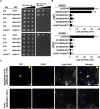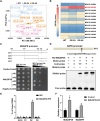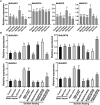SnRK1 kinase-mediated phosphorylation of transcription factor bZIP39 regulates sorbitol metabolism in apple
- PMID: 37067900
- PMCID: PMC10315300
- DOI: 10.1093/plphys/kiad226
SnRK1 kinase-mediated phosphorylation of transcription factor bZIP39 regulates sorbitol metabolism in apple
Abstract
Sorbitol is a major photosynthate produced in leaves and transported through the phloem of apple (Malus domestica) and other tree fruits in Rosaceae. Sorbitol stimulates its own metabolism, but the underlying molecular mechanism remains unknown. Here, we show that sucrose nonfermenting 1 (SNF1)-related protein kinase 1 (SnRK1) is involved in regulating the sorbitol-responsive expression of both SORBITOL DEHYDROGENASE 1 (SDH1) and ALDOSE-6-PHOSPHATE REDUCTASE (A6PR), encoding 2 key enzymes in sorbitol metabolism. SnRK1 expression is increased by feeding of exogenous sorbitol but decreased by sucrose. SnRK1 interacts with and phosphorylates the basic leucine zipper (bZIP) transcription factor bZIP39. bZIP39 binds to the promoters of both SDH1 and A6PR and activates their expression. Overexpression of SnRK1 in 'Royal Gala' apple increases its protein level and activity, upregulating transcript levels of both SDH1 and A6PR without altering the expression of bZIP39. Of all the sugars tested, sorbitol is the only 1 that stimulates SDH1 and A6PR expression, and this stimulation is blocked by RNA interference (RNAi)-induced repression of either SnRK1 or bZIP39. These findings reveal that sorbitol acts as a signal regulating its own metabolism via SnRK1-mediated phosphorylation of bZIP39, which integrates sorbitol signaling into the SnRK1-mediated sugar signaling network to modulate plant carbohydrate metabolism.
© American Society of Plant Biologists 2023. All rights reserved. For permissions, please e-mail: journals.permissions@oup.com.
Conflict of interest statement
Conflict of interest statement. The authors declare no conflicts of interest.
Figures








Similar articles
-
Sorbitol Modulates Resistance to Alternaria alternata by Regulating the Expression of an NLR Resistance Gene in Apple.Plant Cell. 2018 Jul;30(7):1562-1581. doi: 10.1105/tpc.18.00231. Epub 2018 Jun 5. Plant Cell. 2018. PMID: 29871985 Free PMC article.
-
Antisense inhibition of sorbitol synthesis leads to up-regulation of starch synthesis without altering CO2 assimilation in apple leaves.Planta. 2005 Mar;220(5):767-76. doi: 10.1007/s00425-004-1384-5. Epub 2004 Sep 23. Planta. 2005. PMID: 15449063
-
Down-regulation of sorbitol dehydrogenase and up-regulation of sucrose synthase in shoot tips of the transgenic apple trees with decreased sorbitol synthesis.J Exp Bot. 2006;57(14):3647-57. doi: 10.1093/jxb/erl112. Epub 2006 Sep 15. J Exp Bot. 2006. PMID: 16980595
-
Management of plant central metabolism by SnRK1 protein kinases.J Exp Bot. 2022 Nov 15;73(20):7068-7082. doi: 10.1093/jxb/erac261. J Exp Bot. 2022. PMID: 35708960 Free PMC article. Review.
-
Molecular Insights into the Enigmatic Metabolic Regulator, SnRK1.Trends Plant Sci. 2016 Apr;21(4):341-353. doi: 10.1016/j.tplants.2015.11.001. Epub 2015 Nov 28. Trends Plant Sci. 2016. PMID: 26642889 Review.
Cited by
-
A pear S1-bZIP transcription factor PpbZIP44 modulates carbohydrate metabolism, amino acid, and flavonoid accumulation in fruits.Hortic Res. 2023 Jul 21;10(8):uhad140. doi: 10.1093/hr/uhad140. eCollection 2023 Aug. Hortic Res. 2023. PMID: 37575657 Free PMC article.
-
A linker histone acts as a transcription factor to orchestrate malic acid accumulation in apple in response to sorbitol.Plant Cell. 2024 Dec 23;37(1):koae328. doi: 10.1093/plcell/koae328. Plant Cell. 2024. PMID: 39705498 Free PMC article.
-
Low molecular weight carbohydrates and abiotic stress tolerance in lentil (Lens culinaris Medikus): a review.Front Plant Sci. 2024 Oct 3;15:1408252. doi: 10.3389/fpls.2024.1408252. eCollection 2024. Front Plant Sci. 2024. PMID: 39421141 Free PMC article. Review.
-
Identification of Ossnrk1a-1 Regulated Genes Associated with Rice Immunity and Seed Set.Plants (Basel). 2024 Feb 22;13(5):596. doi: 10.3390/plants13050596. Plants (Basel). 2024. PMID: 38475443 Free PMC article.
-
Heterologous Overexpression of Apple MdKING1 Promotes Fruit Ripening in Tomato.Plants (Basel). 2023 Aug 2;12(15):2848. doi: 10.3390/plants12152848. Plants (Basel). 2023. PMID: 37571003 Free PMC article.
References
Publication types
MeSH terms
Substances
LinkOut - more resources
Full Text Sources
Miscellaneous

